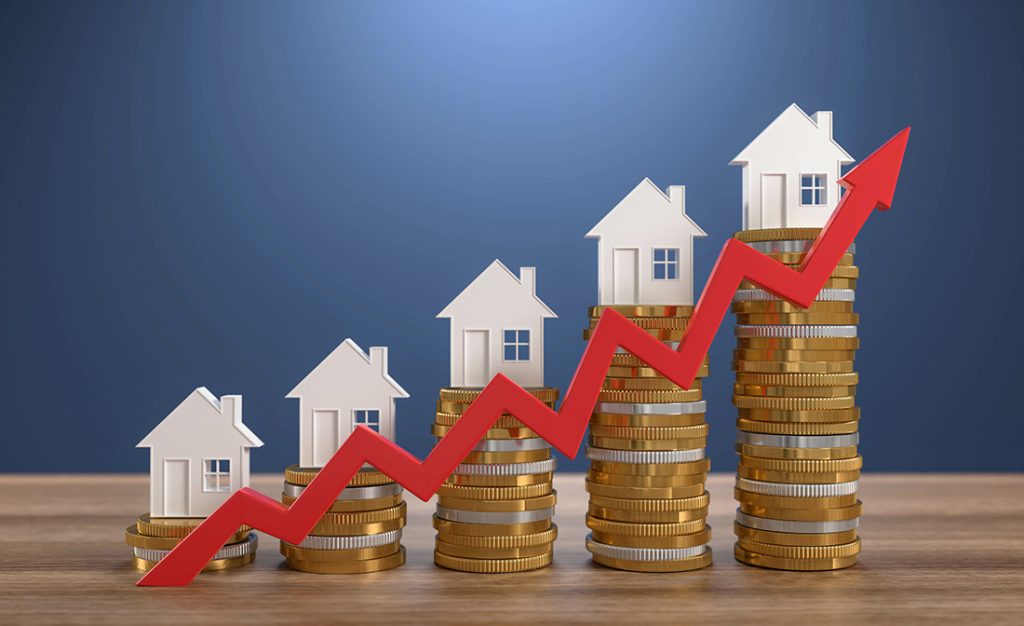- Navigator
- National
- Real Estate Development and Housing

Home prices have taken off dramatically over the last two years, an acceleration of a trend a decade in the making. Nationally, home prices have been on the rise since 2012, making up ground lost as a result of the Great Recession. According to the Case-Shiller US National Home Price Index, it took a full 10 years for prices to recover to their 2006 housing bubble peak, surpassing those levels only in early 2017. What had been a steady upward climb shifted to a near-vertical trajectory with the onset of the pandemic in March 2020. The median sale price in the US reached $413,000 in March, according to data from Redfin, up 17.3% since March 2021 and 36.8% over the 24 months since March 2020. Prior to COVID-19, year-over-year growth tended to be in the mid-single digits.
A number of factors have come together to produce this spike. Will the housing market continue on this trajectory, will it plateau, or are we seeing signs of a bubble?
Reason #1: Record-low mortgage rates
Mortgage rates have been historically low for the last decade, but especially for the last two years. In the last month or two, however, they have trended up considerably and are projected to continue doing so as the Federal Reserve raises rates to combat rising inflation.
Some homebuyers who may have otherwise postponed their home purchasing rushed into the market to take advantage of these low rates, fueling demand and pushing home prices upward. With rates now on the rise, many buyers are locking in lower rates, meaning demand remains high. Demand should begin to slow as rates get higher.
Reason #2: Delayed decisions to sell
Amid the uncertainty brought on by the pandemic, many homeowners postponed their decision to sell their homes. For those that did want to sell, the shortage of new homes available for purchase may have prevented them from doing so. Simply put, if you sell your home, you need another home to move into. Stiff competition for a limited inventory, and high prices as buyers bid up the market, meant that many sellers delayed their decision to sell, further compounding the inventory problem.
Reason #3: Increased geographic mobility
While Americans’ geographic mobility has trended downward for decades, early indicators point to somewhat of a reversal of this trend in the wake of the pandemic. Increased geographic flexibility enjoyed by those who are able to work remotely means that housing demand in certain “Zoom town” locations has been especially strong. More people have relocated or are considering relocating at a higher rate than they were pre-COVID-19, which means more buyers in the market. It remains to be seen if this will play out as a one-time reshuffling of households or an extended trend of people moving more often or farther away than they have in the past.
Reason #4: Shortage of new construction
New home construction has been on an upward swing over the past decade, but the number of new housing units created has lagged below levels needed to prevent price increases. Pandemic-related supply chain snags and soaring materials and labor costs have interplayed with perennial construction-limiting factors, such as restrictive local land use regulations and NIMBYism, to slow the pipeline of new housing production.
Reason #5: Demographic shifts
By sheer nature of their size, demand from the large Millennial and Baby Boomer generations tends to drive the housing market. As Millennials increasingly form their own households and reach prime homebuying age (the median age of the first-time homebuyer is 33, according to the National Association of Realtors), demand for for-sale housing remains strong. Meanwhile, the increasing longevity of Baby Boomers means they are able remain in their homes longer (the vast majority of seniors prefer to “age in place” when it comes to future housing choices), meaning less inventory on the market for younger generations.
Reason #6: Greater investor activity
Investors are snapping up housing inventory at higher rates than before, motivated by low interest rates and high rent potential. This results in a share of housing being converted from owner-occupied to rental inventory and translates to less for-sale supply for homebuyers to choose from. This increased competition from investors plays a role in driving up prices for owner-occupiers.
Overall, demand is likely to soften somewhat as mortgage rates rise and the buying frenzy cools. At this moment, analyst consensus seems to be that home prices will continue to rise into the near future albeit at more modest rates. In some less in-demand markets, we may see some price declines as the market self-corrects. By and large, the factors at play contributing to high demand and limited supply will persist but become less acute. That means we’re unlikely to see a Great Recession-style housing crash any time soon.





